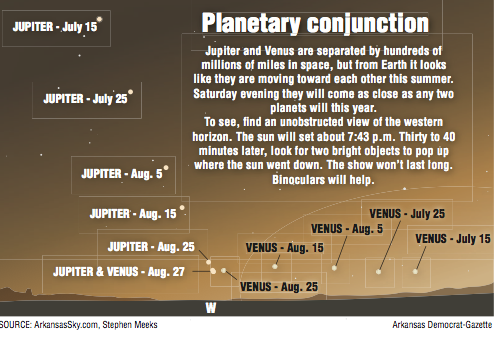Many skywatchers don't own a telescope or a physics degree.
From the movements of heavenly bodies to the meaning of clouds, this new occasional feature, What's Up, will share advice and tips from amateurs or professionals about sky things visible to the nekkid eyes or through binoculars.
COMING SATURDAY
An astronomical event will occur just after sundown on the western horizon Saturday.
Venus and Jupiter, two brilliant planets, will appear close together -- the closest any two planets will approach each other in all of 2016.
The time to look is 30 to 40 minutes after the sun sets (at 7:43 p.m.), when these two bright dots will be very close together in the western sky close to the horizon where the sun went down.
This planetary "conjunction" could be visible to the naked eye, assuming a good set of eyes and helpful weather. But a good set of binoculars is a better bet, says Darrell Heath, a biologist and staff member at the University of Arkansas at Little Rock.
To see the sight, "you want a clear, unobstructed view toward the western horizon," Heath says. Logical spots include high hilltops, ridges and places labeled "observation decks," and it's smart to try them out at sundown before Saturday. (This also would let you gauge the effectiveness of your bug spray.)
The conjunction will appear "very, very low upon the horizon," Heath says, and it will only be visible for an hour to an hour and a half before the planets will drop from view.
While some sources note that the conjunction could be visible in daylight, he warns that aiming binoculars at the sun is too dangerous to risk. "All it takes is just a split second to let your binoculars wander across the sun and you've cooked the inside of your eyeballs," he says. So wait until after sunset.
Heath shares his knowledge of things astronomical through the UALR University Television video series The Night Sky, available in central Arkansas on Comcast and UVerse and through ualr.edu/tv/night-sky as well as YouTube.com.
Of course the planets won't actually be near one another. According to the planetary distance calculator at theplanets.org, on average Jupiter and Venus are more than 416 million miles apart. But from our perspective on Earth, their elliptical orbits around the sun create a line of sight illusion such that these two shiny objects have been moving closer and closer together all summer.
ActiveStyle on 08/22/2016

